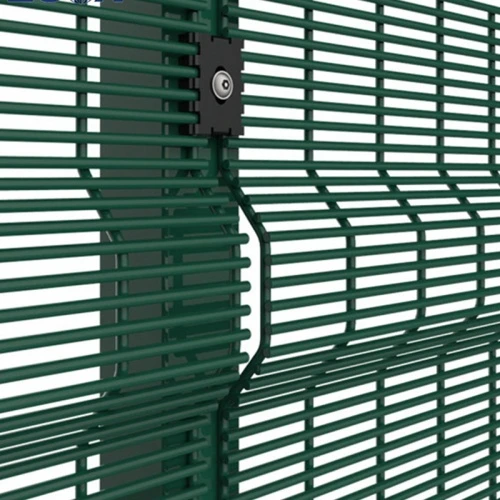358 3D guardrail, also known as 358 anti-climb guardrail, is a high-security protective fence. Its name comes from the mesh size specification: 3 inches × 0.5 inches × 8 feet (about 76.2 mm × 12.7 mm × 4 mm).This unique mesh design makes it extremely resistant to climbing and cutting, becoming one of the most difficult to penetrate rigid meshes. Usually, 358 3D guardrail is made of galvanized steel or vinyl-coated steel, which has excellent corrosion resistance and is suitable for a variety of harsh environments. Its sturdy structure and durable materials make it widely used in places that require high security, such as prisons, military bases, and industrial parks.
Where Is a 358 3D Metal Fence Commonly Used?
A 358 3D metal fence is widely used in various applications due to its exceptional security and durability. One of the most common uses is in high-security facilities such as prisons and detention centers. The small mesh openings make it nearly impossible for inmates to climb or cut through, providing a highly effective security barrier. The fence is also strong enough to withstand forceful attempts at breaching, ensuring that restricted areas remain protected. Another major application is in military and defense installations. Military bases, armories, and border security areas use 358 fences to prevent unauthorized access while allowing surveillance personnel to maintain clear visibility of the perimeter. These fences are often reinforced with additional security measures such as electrified wires or motion sensors to enhance protection. Airports and transportation hubs also commonly use 358 3D metal fencing. Airports require a secure perimeter to prevent trespassing and unauthorized entry onto runways and restricted zones. The clear visibility of the fence allows security personnel and cameras to monitor activities without obstruction, making it an ideal choice for airport fencing. Similarly, railway stations and bridges use 358 fences to enhance public safety and prevent trespassing. Schools and educational institutions benefit from 358 fencing as well. Schools need fencing that provides security while maintaining an open and welcoming environment. The anti-climb design ensures that students remain safe within school grounds, while the transparent structure allows school staff to monitor activities both inside and outside the premises. Industrial and commercial facilities frequently install 358 3D metal fences to protect valuable equipment, inventory, and restricted areas. Factories, warehouses, and power plants use these fences to secure their perimeters against theft, vandalism, and unauthorized entry. The durability and weather resistance of the fence make it an ideal choice for outdoor industrial applications. Power stations and utility plants also utilize 358 fencing to prevent unauthorized access to hazardous areas. Electrical substations, water treatment plants, and other critical infrastructure sites rely on high-security fencing to safeguard against potential threats.
How Does a 358 3D Metal Fence Compare to Other Security Fencing Options?
A 358 3D metal fence offers distinct advantages over other security fencing options, making it a preferred choice for high-security applications. When compared to chain link fencing, 358 fencing provides significantly higher security. Chain link fences can be easily cut with bolt cutters, and they offer footholds for climbing. In contrast, the small mesh size of a 358 fence makes it nearly impossible to cut or climb, making it far superior for security-sensitive areas. Compared to palisade fencing, 358 fencing offers better visibility and aesthetics. Palisade fences, with their pointed steel pales, provide strong security but can create blind spots due to their solid structure. In contrast, 358 fencing maintains a high level of security while allowing for clear visibility, making surveillance easier. However, palisade fencing may still be preferred for areas requiring a highly intimidating security barrier. When comparing 358 fencing to welded mesh fencing with larger apertures, 358 fencing is the more secure option. Other welded mesh fences may provide a similar appearance but lack the anti-climb and anti-cut properties of the 358 design. Additionally, 358 fencing is stronger and more impact-resistant than traditional welded mesh fencing, making it the better choice for high-risk environments. In comparison to solid concrete walls, 358 fences provide security without creating enclosed, isolated areas. Concrete walls can block visibility and make it difficult for security personnel to monitor surroundings, whereas 358 fences allow for clear sightlines while still providing a formidable barrier. Concrete walls also require more materials and labor for installation, making them more expensive and less adaptable than 358 fences. In contrast to aluminum or ornamental wrought iron fencing, 358 fencing is specifically designed for security rather than decorative purposes. While wrought iron fences may offer an elegant appearance, they are more vulnerable to cutting tools and climbing compared to the tightly spaced mesh of 358 fencing. Similarly, aluminum fencing is lightweight and corrosion-resistant but lacks the strength and security features necessary for high-risk locations. In conclusion, 358 3D metal fencing outperforms chain link, palisade, welded mesh, concrete, aluminum, and ornamental fencing in terms of security, strength, visibility, and durability. It is an ideal choice for any environment requiring high-security fencing without compromising surveillance and long-term reliability.








